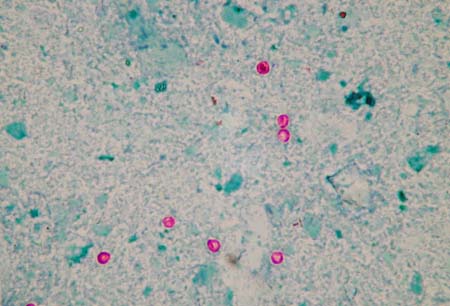Summary
Definition
History and exam
Key diagnostic factors
- diarrhea
Other diagnostic factors
- abdominal pain
- vomiting
- loss of appetite
- low-grade fever
- loss of weight
- right upper quadrant abdominal pain
- jaundice
- nasal discharge and facial pain
- cough and dyspnea
Risk factors
- contact with farm animals, especially calves and lambs
- international travel
- age: 3 years or younger
- immune deficiency: T-cell-mediated
- swimming and recreational water sports
- drinking unfiltered water
- toileting or changing diapers of young children
- Malnutrition
Diagnostic tests
1st tests to order
- polymerase chain reaction (PCR) for Cryptosporidium species identification
- stained stool microscopy
- Cryptosporidium antigen detection
Tests to consider
- ultrasound scan of the biliary tract
- CT scan of the biliary tract
- endoscopic retrograde cholangiopancreatography (ERCP)
Treatment algorithm
immunocompetent
immunocompromised
Contributors
Authors
Rachel M. Chalmers, BSc, PhD
Consultant Clinical Scientist/Honorary Professor
Director of the Cryptosporidium Reference Unit (England and Wales)
Public Health Wales Microbiology
Singleton Hospital
Swansea
UK
Disclosures
RMC is an author of a number of references cited in this topic.
Angharad P. Davies, MA, MBBCh, MRCP, FRCPath, PhD
Clinical Associate Professor
College of Medicine
Swansea University
Swansea
UK
Disclosures
APD is a Trustee Board Member for the Royal College of Pathologists and is an author of a number of references cited in this topic.
Peer reviewers
Shauna Gunaratne, MD, MPH, DTM&H, CTropMed
Assistant Professor of Clinical Medicine
Department of Medicine
Division of Infectious Diseases
Columbia University Irving Medical Center
New York
NY
Disclosures
SG declares that she has no competing interests.
Judy Streit, MD
Clinical Professor
University of Iowa Hospitals and Clinics
Iowa City
IA
Disclosures
JS declares that she has no competing interests.
Peer reviewer acknowledgements
BMJ Best Practice topics are updated on a rolling basis in line with developments in evidence and guidance. The peer reviewers listed here have reviewed the content at least once during the history of the topic.
Disclosures
Peer reviewer affiliations and disclosures pertain to the time of the review.
References
Key articles
Centers for Disease Control and Prevention. CDC Yellow Book 2024: health information for international travel. Section 5: travel-associated infections and diseases - cryptosporidiosis. May 2023 [internet publication].Full text
Shane AL, Mody RK, Crump JA, et al. 2017 Infectious Diseases Society of America clinical practice guidelines for the diagnosis and management of infectious diarrhea. Clin Infect Dis. 2017 Nov 29;65(12):1963-73.Full text Abstract
National Institutes of Health, Centers for Disease Control and Prevention, HIV Medicine Association, and Infectious Diseases Society of America. Panel on Guideline for the Prevention and Treatment of Opportunistic Infections in Children with and Exposed to HIV. Guidelines for the prevention and treatment of opportunistic infections in children with and exposed to HIV: Cryptosporidiosis. 2019 [internet publication].Full text
National Institutes of Health, Centers for Disease Control and Prevention, HIV Medicine Association, and Infectious Diseases Society of America. Panel on Guidelines for the Prevention and Treatment of Opportunistic Infections in Adults and Adolescents with HIV. Guidelines for the prevention and treatment of opportunistic infections in adults and adolescents with HIV: cryptosporidiosis. 2023 [internet publication].Full text
Reference articles
A full list of sources referenced in this topic is available to users with access to all of BMJ Best Practice.

Differentials
- Acute diarrhea
- Chronic diarrhea
- Crohn disease
More DifferentialsGuidelines
- Health information for international travel (Yellow Book): cryptosporidiosis
- Prevention and treatment of opportunistic infections in adults and adolescents with HIV
More GuidelinesPatient information
Diarrhea in adults
Diarrhea in children
More Patient informationLog in or subscribe to access all of BMJ Best Practice
Use of this content is subject to our disclaimer